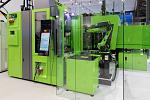- FMA
- The Fabricator
- FABTECH
- Canadian Metalworking
Nanotwinned titanium forges path to sustainable manufacturing
- March 10, 2022
- News Release
- Management

Scientists at Berkeley Lab’s Molecular Foundry used an electron microscopy technique called electron backscatter diffraction (EBSD) to image the structure of pure titanium with a nanotwinned structure. Each colour represents a unique orientation of the grains. The thin strips reveal the nanotwinned structure produced through cryoforging. Andy Minor/Berkeley Lab
Titanium is strong and lightweight, boasting the highest strength-to-weight ratio of any structural metal. But processing it while maintaining a good balance of strength and ductility–the ability of a metal to be drawn out without breaking–is challenging and expensive.
Researchers at the Lawrence Berkeley National Laboratory (Berkeley Lab) have discovered a new and practical path forward, though. The team found that they could use cryoforging to manipulate pure titanium on a nanometre scale (a billionth of a metre) at ultra-low temperatures to produce extra-strong “nanotwinned” titanium without sacrificing ductility.
“This study is the first time someone has produced a pure nanotwinned structure in bulk material,” said Andrew Minor, the study’s project lead and director of the National Center for Electron Microscopy at the Molecular Foundry at Berkeley Lab. “With nanotwinned titanium, we no longer have to choose between strength and ductility but instead can achieve both.”
The mechanical properties of metals depend in part on the grains that form the material’s internal structure. Boundaries between grains, where the pattern changes, strengthen metals by stopping defects known as dislocations from moving across and weakening the material’s structure.
One way to strengthen a metal is to shrink the size of its grains to create more boundaries by forging it. However, this type of processing often comes at the expense of ductility and the internal structure gets broken up, making it prone to fracture.
“High strength and ductility are generally mutually exclusive properties,” said Minor.
Enter nanotwins. Nanotwins are a specific type of atomic arrangement where the tiny boundaries in the crystal structure line up symmetrically, like mirror images of each other. Nanotwinned materials are not new. However, making them typically requires specialized techniques that can be costly. These techniques have worked for a select set of metals like copper and are typically only used to make thin films. Furthermore, most of the time thin-film properties don’t translate to bulk materials.
The cryoforging technique starts with a cube of very pure (more than 99.95 per cent) titanium placed into liquid nitrogen at -321 degrees F. While the cube is submerged, compression is applied to each axis of the cube. Under these conditions, the structure of the material begins to form nanotwin boundaries. The cube later is heated to 750 degrees F to remove any structural defects that formed in between the twin boundaries.
The researchers put the newly formed material through a series of stress tests and used the Molecular Foundry’s electron microscopes to uncover the source of its unique properties. During these tests, they found that nanotwinned titanium had better formability because it can form new nanotwin boundaries and undo previously formed boundaries, both of which help with deformation.
They tested the material to temperatures up to 1,112 degrees F and found it maintained its structure and properties. Also, at super-cold temperatures, nanotwinned titanium can withstand more strain than normal titanium.
The researchers found that nanotwinning doubled the metal’s strength and increased its ductility by 30 per cent at room temperature. At super-low temperatures, the improvement was even more dramatic–the nanotwinned titanium was able to double in length before fracturing.
Fabricating nanotwinned titanium using cryoforging is potentially cost-effective, scalable for commercial production, and produces an easily recycled product.
The team’s study, “Cryoforged nanotwinned titanium with ultrahigh strength and ductility,” was published in the journal Science.
By Julie Fornaciari
subscribe now


Keep up to date with the latest news, events, and technology for all things metal from our pair of monthly magazines written specifically for Canadian manufacturers!
Start Your Free Subscription- Industry Events
MME Saskatoon
- May 28, 2024
- Saskatoon, SK Canada
CME's Health & Safety Symposium for Manufacturers
- May 29, 2024
- Mississauga, ON Canada
DiPaolo Machine Tools Open House 2024
- June 4 - 5, 2024
- Mississauga, ON Canada
FABTECH Canada
- June 11 - 13, 2024
- Toronto, ON Canada
Zoller Open House & Technology Days 2024
- June 12 - 13, 2024
- Ann Arbor, MI



















